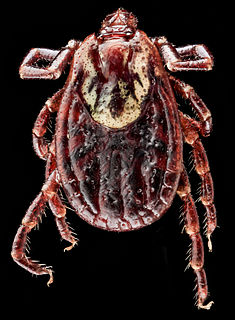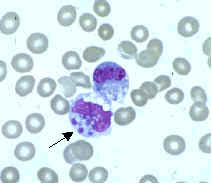
Poliovirus, the causative agent of polio, is a member virus of Enterovirus C, in the family of Picornaviridae.
Tick-borne diseases, which afflict humans and other animals, are caused by infectious agents transmitted by tick bites. Tick-borne illnesses are caused by infection with a variety of pathogens, including rickettsia and other types of bacteria, viruses, and protozoa. Because individual ticks can harbor more than one disease-causing agent, patients can be infected with more than one pathogen at the same time, compounding the difficulty in diagnosis and treatment. As of 2016, 16 tick-borne diseases of humans are known.

Bunyavirales is an order of negative-sense single-stranded RNA viruses. It is the only order in the class Ellioviricetes. It was formerly known as Bunyaviridae family of viruses. The name Bunyavirales derives from Bunyamwera, where the original type species Bunyamwera orthobunyavirus was first discovered. Ellioviricetes is named in honor of late virologist Richard M. Elliott for his early work on bunyaviruses.
Kyasanur forest disease (KFD) is a tick-borne viral haemorrhagic fever endemic to South India. The disease is caused by a virus belonging to the family Flaviviridae, which also includes yellow fever and dengue fever.

Thogotovirus is a genus of enveloped RNA viruses, one of seven genera in the virus family Orthomyxoviridae. Their single-stranded, negative-sense RNA genome has six or seven segments. Thogotoviruses are distinguished from most other orthomyxoviruses by being arboviruses – viruses that are transmitted by arthropods, in this case usually ticks. Thogotoviruses can replicate in both tick cells and vertebrate cells; one subtype has also been isolated from mosquitoes. A consequence of being transmitted by blood-sucking vectors is that the virus must spread systemically in the vertebrate host – unlike influenza viruses, which are transmitted by respiratory droplets and are usually confined to the respiratory system.

Erythema migrans refers to a rash often seen in the early stage of Lyme disease, and can also be caused by southern tick-associated rash illness (STARI). It can appear anywhere from one day to one month after a tick bite. This rash does not represent an allergic reaction to the bite, but rather an actual skin infection of one of the Lyme bacteria species from the genus Borrelia.

Dermacentor variabilis, also known as the American dog tick or wood tick, is a species of tick that is known to carry bacteria responsible for several diseases in humans, including Rocky Mountain spotted fever and tularemia. It is one of the most well-known hard ticks. Diseases are spread when it sucks blood from the host, which could take several days for the host to experience some symptoms.
In the diagnostic laboratory virus infections can be confirmed by a multitude of methods. Diagnostic virology has changed rapidly due to the advent of molecular techniques and increased clinical sensitivity of serological assays.

Southern tick-associated rash illness (STARI) or Masters' disease is an emerging infectious disease related to Lyme disease that occurs in southeastern and south-central United States. It is spread by tick bites, but the organism that causes the infection is unknown.
Ehrlichia chaffeensis is an obligate intracellular gram-negative species of rickettsiales bacteria. It is a zoonotic pathogen transmitted to humans by the lone star tick. It is the causative agent of human monocytic ehrlichiosis.

Human monocytotropic ehrlichiosis (HME) is a form of ehrlichiosis associated with Ehrlichia chaffeensis. This bacterium is an obligate intracellular pathogen affecting monocytes and macrophages.
Ehrlichiosis ewingii infection is an infectious disease caused by an intracellular bacteria, Ehrlichia ewingii. The infection is transmitted to humans by the tick, Amblyomma americanum. This tick can also transmit Ehrlichia chaffeensis, the bacteria that causes human monocytic ehrlichiosis (HME).

African tick bite fever (ATBF) is a bacterial infection spread by the bite of a tick. Symptoms may include fever, headache, muscles pains, and a rash. At the site of the bite there is typically a red skin sore with a dark center. Onset usually occur 4–10 days after the bite. Complications are rare, however may include joint inflammation. Some people do not develop symptoms.
The transmission of hepadnaviruses between their natural hosts, humans, non-human primates, and birds, including intra-species host transmission and cross-species transmission, is a topic of study in virology.
Huaiyangshan banyangvirus, formerly SFTS virus, is a tick-borne Banyangvirus in the order Bunyavirales. It appears to be more closely related to the Uukuniemi virus serogroup than to the Sandfly fever group. It is a member of the Bhanja virus serocomplex.
Royal Farm virus, previously known as Karshi virus, was not viewed as pathogenic or harmful to humans. Although infected people suffer with fever-like symptoms. Some people in Uzbekistan have reported with severe disease such as encephalitis and other large outbreaks of fever illness connected infection with Karshi virus.
Tibovirus Is term is often used to describe viruses that are transmitted by tick vectors. The word tibovirus is an acronym. This falls within the superorder arthropod thus tibovirus is classified under Arthropod Borne virus (Arborvirus). For a person to acquire infection the tick must bite and feed for a sufficient period of time. The tiboviruses that affect humans are limited to within 3 families: Flaviviridae, Reoviridae, and Bunyaviridae.
The Nairobi sheep disease orthonairovirus (NSDV), also known as Ganjam virus is a species in the genus Orthonairovirus belonging to the Nairobi sheep disease serogroup. NSDV's known hosts belong to the hard tick family Ixodidae, including Rhipicephalus appendiculatus, and Amblyomma variegatum, and afflict sheep and goats naturally.







